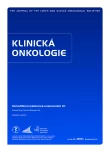Syndromes Predisposing to Cancer in Children – the Experience of Pediatric Oncology Departmentof University Hospital Brno
Authors:
V. Bajčiová
Authors‘ workplace:
Klinika dětské onkologie LF MU a FN Brno
Published in:
Klin Onkol 2016; 29(Supplementum 1): 62-70
Category:
Review
doi:
https://doi.org/10.14735/amko2016S62
Overview
There is a broad spectrum of hereditary cancer predisposition syndromes affecting pediatric population. Early genetic testing establishing the diagnosis may assist in patient dispensarisation and management. Secondary prevention and prompt diagnosis of cancer improves the prognosis and overall survival. A centralised dispensarisation of pediatric patients with hereditary cancer predisposition syndromes on pediatric oncology department offers complex multidisciplinary care to the patient and his family.
Key words:
hereditary cancer predisposition syndromes – dysmorphology – pediatric cancer – genetic testing
The author declares she has no potential conflicts of interest concerning drugs, products, or services used in the study.
The Editorial Board declares that the manuscript met the ICMJE recommendation for biomedical papers.
Submitted:
14. 7. 2015
Accepted:
18. 8. 2015
Sources
1. Schiffman JD, Keller JI, Jundy E et al. Update on pediatric cancer predisposition syndromes. Pediatr Blood Cancer 2013; 60(8): 1247– 1252. doi: 10.1002/ pbc.24555.
2. American Society of Clinical Oncology. American Society of Clinical Oncology policy statement update: genetic testing for cancer susceptibility. J Clin Oncol 2003; 21(12): 2397– 2406.
3. Bjorge T, Cnattingius S, Lie RT et al. Cancer risk in children with birth defects and their families: a population based cohort study of 5.2 million children from Norway and Sweden. Cancer Epidemiol Biomarkers Prev 2008; 17(3): 500– 506. doi: 10.1158/ 1055‑ 9965.EPI‑ 07‑ 2630.
4. Botto LD, Flood T, Little J et al. Cancer risk in children and adolescents with birth defects: a population‑based kohort study. PLoS One 2013; 8(7): e69077. doi: 10.1371/ journal.pone.0069077.
5. Testa JR, Malkin D, Schiffman JD. Connecting molecular pathways to hereditary cancer risk syndromes. Am Soc Clin Oncol Educ Book 2013; 81– 90. doi: 10.1200/ EdBook_AM.2013.33.81.
6. Foretová L. Hereditární malignity si zaslouží víc pozornosti než dosud. Kongresová review. XXXIX. brněnské onkologické dny a XXIX. konference pro nelékařské zdravotnické pracovníky, 8.– 10. 4. 2015, Brno.
7. Závodná K, Milly M, Vavrová L et al. Dědičné nádorové syndromy. Onkológia 2015; 10(2): 84– 89.
8. Frank C, Fallad M, Sundquist J et al. Population landscape of familial cancer. Sci Rep 2015; 5: 12891. doi: 10.1038/ srep12891.
9. Clarke AJ, Gaff C. Challenges in the genetic testing of children for familial cancer. Arch Dis Child 2008; 93(11): 911– 914. doi: 10.1136/ adc.2006.113381.
10. Malkin D, Nichols KE, Zelley K et al. Predisposition to pediatric and hematologic cancer: a moving target. Am Soc Clin Oncol Educ Book 2014; e44– e55. doi: 10.14694/ EdBook_AM.2014.34.e44.
11. Quinn E, McGee R, Nuccie R et al. Genetic predisposition to neonatal tumors. Curr Pediatr Reviews 2015; 11(3): 164– 178.
12. Škvor J, Průhová Š. Základy klinické genetiky pro klinickou praxi. Genetika v primární péči: 5– 6. Mladá fronta 2014.
13. Papakasama S, Tomlinson GE. Genetic predisposition and screening in pediatric cancer. Pediatr Clin North Am 2002; 49(6): 1393– 1413.
14. Rao A, Rothman J, Nichols KE. Genetic testing and tumor surveillance for children with cancer predisposition syndromes. Curr Opin Pediatr 2008; 20(1): 1– 7. doi: 10.1097/ MOP.0b013e3282f4249a.
15. Foretová L, Petráková K. Dispenzarizace dědičných nádorových syndromů. Klin Onkol 2009; 22 (Suppl): S6– S77.
16. Ilenčíková D, Amidová O, Konečný M et al. Genetická konzultácia jako súčasť genetického vyšetrenia. Onkológia 2015; 10(2): 74– 76.
17. Teplick A, Kowalski M, Biegel JA et al. Screening in cancer predisposition syndromes: guidelines for the general pediatricians. Eur J Pediatr 2011; 170(3): 285– 294. doi: 10.1007/ s00431‑ 010‑ 1377‑ 2.
18. Foretová L, Macháčková E, Gaillyová R et al. Hereditární nádorová onemocnění. In: Foretová L, Svoboda M,Slabý O et al (eds). Molekulární genetika v onkologii. Praha: Mladá fronta 2014: 116– 155.
19. Field M, Shanley S, Kirk J. Inhereted cancer susceptibility syndromes in paediatric practice. J Pediatr Child Health 2007; 4(4): 219– 229.
20. Lang M, Gasche C. Chemoprevention of colorectal cancer. Dig Dis 2015; 33(1): 58– 67. doi: 10.1159/ 000366037.
21. Thakkar K, Fishman DS, Gilger MA. Colorectal polyps in childhood. Curr Opin Ped 2012; 24(5): 632– 637. doi: 10.1097/ MOP.0b013e328357419f.
22. Ilenčíková D. Syndrom konstitučního deficitu mismč opravného systému (CMMR‑ D). Kazuistika rodiny s bialelickou MSH6 mutáciou. Klin Onkol 2012; 25 (Suppl): S34– S38.
23. Vasen HF, Ghorbanoghli Z, Bourdeaut F et al. Guidelines for surveillance of individuals with constitutional mismatch realit‑ deficiency proposed by the European Consortium „Care for CMmR‑ D“ (C4CMmR‑ D). J Med Genet 2014; 51(5): 283– 293. doi: 10.1136/ jmedgenet‑ 2013‑ 102238.
Labels
Paediatric clinical oncology Surgery Clinical oncologyArticle was published in
Clinical Oncology

2016 Issue Supplementum 1
- Metamizole vs. Tramadol in Postoperative Analgesia
- Metamizole at a Glance and in Practice – Effective Non-Opioid Analgesic for All Ages
- Possibilities of Using Metamizole in the Treatment of Acute Primary Headaches
- Current Insights into the Antispasmodic and Analgesic Effects of Metamizole on the Gastrointestinal Tract
- Spasmolytic Effect of Metamizole
Most read in this issue
- PALB2 as Another Candidate Gene for Genetic Testing in Patients with Hereditary Breast Cancer in Czech Republic
- Hepatoblastoma, Etiology, Case Reports
- Genetics of Colorectal Tumorigenesis (Possibilities of Testing and Screening Prediction of Hereditary Form of Colorectal Cancer – Lynch Syndrome)
- Fanconi Anemia, Complementation Group D1 Caused by Biallelic Mutations of BRCA2 Gene – Case Report
